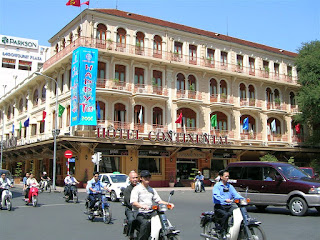Les Grandes Chasses en Indochine was a sales brochure prepared for the 1937 Paris Exposition. It described the various big (and small) game that could be found in Vietnam. Tigers, elephants, rhinos, deer, bears, birds, crocodiles and wild buffalo could be hunted by those so inclined. Advertising featured safari services, guns, ammunition and taxidermy services.
A first class luxury safari is offered:
"First class guide speaking English and local languages. Good cars. Comfortable hunting bungalow with brick house with two first class bathrooms with running water, modern facilities, dining room, verandah, veranda, electric light and all the and all possible comfort. This bungalow is built in the heart of the jungle, in the middle of a very gamey area, 10 hours drive from Saigon. Excellent food, fresh vegetables, drinks, wine and ice. Housekeepers to wash clothes, take care of weapons and equipment. Camp staff, skinners, etc. Best equipment, double canvas tents, camp beds, mosquito nets, in case it is necessary to camp outside. Ox carts, saddle horses, porters to go where the cars cannot penetrate."
All of this cost 3,600 piastres for a month for two hunters plus 500 piastres
for an additional guide.
A list of clients of the D & D Safari
Service includes former US President Theodore Roosevelt.
|
The entire Les Grandes Chases en Indochine brochure can be seen using the link button to the right. It is in PDF format. |




































